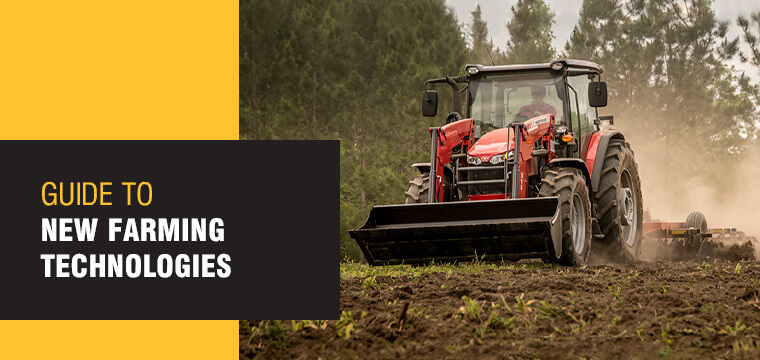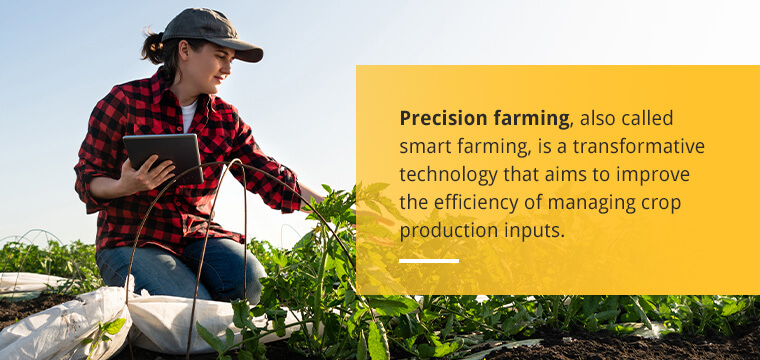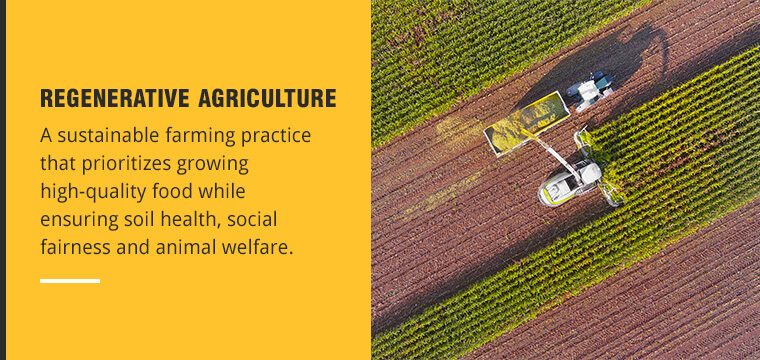
Agriculture has changed drastically in the last 12,000 years, from the plow that Egyptians invented in 3500 BCE and the tractors that came in the late 17th century to fully automated farming systems today. All these innovative technologies have revolutionized farming, making it less labor-intensive and more productive for farmers globally.
In the 20th and 21st centuries, technology and farming created some ground-breaking tools propelled by the invention of computers, the internet and the availability of big data. In this guide, we discuss the most impressive new farming technologies that contribute to the viability of agriculture today.
Farming technology, also referred to as agriculture technology or precision agriculture, is the use of machinery, tools and equipment to control the planting, growth and harvesting of crops. It helps boost farm yields while making crop production, processing and distribution more efficient and convenient for all the players on the agri-food chain. These players include farmers, agricultural consultants, technology managers and food producers.
Precision Agriculture can also ensure safe food growing conditions, packaging and distribution while reducing the environmental and ecological impact of farming activities. This means it enables more sustainable farming practices, minimizes carbon emissions and decreases the negative environmental impact of farming on land, air and water.
Modern agriculture technology and farming are crucial for dealing with modern-day food chain problems caused by climate change, population growth and increasing food demand.
Explore the top inventions and improvements in farm technology that help farmers work more effectively and efficiently on their farms while increasing yields and productivity.
Precision farming, also called smart farming, is a transformative technology that aims to improve the efficiency of managing crop production inputs. It has fueled the development of numerous farming tools and equipment that ensure farmers can maximize their yield by optimizing all crop production inputs, including:

While precision farming tools require a significant investment, they ensure more accurate planting and growing practices that reduce crop production costs and time and increase profitability in the long term. These tools enable real-time farm observation and accurate measurement and analysis of farm operations.
Precision farming is also a sustainable practice that helps maintain the natural ecosystem by reducing land losses, ensuring efficient water use, maintaining soil health and reducing agriculture’s dependence on weather conditions.
The following are the top tools and technologies used in precision farming:
Satellite-based navigation systems provide farmers with real-time location and time information. This data helps them to navigate the field and monitor crop conditions accurately. It can also be used to map field boundaries, irrigation systems, roads, drainage ditches and problem areas, such as locations prone to weeds and disease attacks. On the farm, GPS tools are mounted on farm equipment and tools, such as sowing machines, tractors, harvesters and smart irrigation systems, to facilitate accurate planning and scheduling of farm operations.
A geographic information system (GIS) is a computerized data management system used to gather, store, organize, analyze, manipulate, manage and display spatial information. GPS enables precise farm mapping and, in combination with appropriate GIS software, provides insights to the farmers about the crop status and the parts of the farm that require inputs like water, fertilizer or pesticides. GPS and GIS integration analyze farm elevation levels, irrigation systems, crop varieties and field boundaries to achieve efficient resource use.
Satellite crop monitoring and imaging or satellite remote sensing uses satellites equipped with specialized cameras and sensors that capture high-resolution images of farms. Farmers use this new farming technology to inform their decision-making processes because it provides close-up and real-time crop imagery of yield maps and soil surveys or fertilization maps.
The satellite farm images can be used for numerous purposes, including:
Real-time kinematic (RTK) technology refers to guidance control equipment that helps farmers calculate the position of automated equipment on the field. They boost the accuracy of GPS signals using receivers and base stations to achieve precision up to 1 centimeter in field operations. RTK technology uses GPS signals, a local base station and a data link to supply accurate positioning and navigation data.
These signals improve efficiency and accuracy during tilling, seeding, spraying and harvesting crops on farms of all sizes. RTK systems reduce fuel consumption and the time taken to complete farm operations. RTK technology is employed for a wide variety of precision agriculture applications, including:
Precision agriculture enables the collection of a lot of data from farm management software that farmers can access, monitor and analyze at any time. These solutions help digitize farm management processes, making operations more efficient. Integrating farming management software into farm operations has many benefits, including:
The Trimble Ag Software allows real-time access to data and information so farmers can manage and sync all their farm operations. It helps them manage daily farm and work activities efficiently to get more done by providing real-time data and simplifying data transfer and sharing. The Trimble Ag Software is a multi-functional tool that facilitates a wide range of operations, including record-keeping, agronomics and workflow management.
Some of the key features of the Trimble Ag Software include:
Auto-guidance or auto-steer equipment of agricultural machines assists farmers in covering fields more quickly and accurately. They use satellite-based GPS receivers or position equipment to establish controlled equipment patterns on farms without gaps, overlaps and skips. Steering equipment also helps to prevent soil compaction, reduce operator fatigue and improve visibility conditions.
Trimble has various automated steering systems that maintain tractors, combines, sprayers and other vehicles on farms on the correct path despite the terrain type or field pattern. Some of these steering systems include:

Regenerative agriculture is a sustainable farming practice that prioritizes growing high-quality food while ensuring soil health, social fairness and animal welfare. With regenerative farming, farmers can produce organic food that nourishes their local communities and preserves the natural ecosystems for future use. It’s built on the principle of enriching the soil or preserving biological factors that affect its fertility, such as fungi, bacteria and soil microbes.

Regenerative agriculture also advocates for reducing the reliance on synthetic chemicals, such as fertilizers, herbicides and pesticides, to cut food production costs and reduce human health risks. Additionally, this new technology in farming and agriculture helps nurture communities by encouraging fair treatment and wages for all farmworkers.
Adopting regenerative agriculture also helps reduce carbon emissions by turning farms into carbon sinks. Soil is a carbon sink that absorbs more carbon dioxide from the atmosphere than it releases, helping us to reduce the amount of carbon emissions in the air. Some of the most effective and practiced regenerative agriculture practices include:
No-till farming is a modern farming technique that involves planting crops without plowing the land or other soil-disrupting practices. This technique causes minimal soil disturbances, resulting in less soil erosion and evaporation of moisture to increase the soil’s fertility, quality and resilience. No-till farming produces higher crop yields using numerous methods to manage weeds and suppress plant diseases.
Composting is the natural process of converting organic waste material, like food or manure, into a stable and nutrient-rich soil amendment. This modern farming technique uses compost and mulch to improve soil properties and boost the yields for perennials, orchards, annual crops, vineyards and grasslands. Composing boasts many advantages for farmers, which include promoting healthier plant growth, reducing waste and combating climate change.
Cover cropping is a method of planting crops to cover the soil, improve its health and water availability, control pests and diseases, and slow down erosion after cash crops are harvested. Cover crops are not necessarily meant for bulk harvesting. They typically include legumes and broad-leaf non-legumes, such as barley, alfalfa, cowpea, ryegrass, sorghum and millet.
Crop rotation involves planting different types of crops in a specific area between the growing seasons. Crop rotation diversifies the microorganisms in the soil, builds stable organic matter and improves crop resilience. It’s an effective way of improving soil health, reducing erosion and decreasing pathogens and weeds from season to season.
Modern technology in farming has made agricultural production more efficient and even boosted crop yields in numerous ways, but it has also had a few negative impacts on the environment, community and ecosystems. Below, we get into the top advantages and disadvantages of technology in farming.
The following are the ways modern technology has benefited farming:
Here are some of the top disadvantages of new farming technology:
New farming technology can help you diversify your farm, reduce costs, and increase yield and productivity. But, to reap these benefits, you must invest in innovative technology that enhances your farming efficiency and effectiveness. Holt Ag Solutions is a one-stop machinery shop that provides top-quality new and used farm equipment and technology to help you optimize your farm operations. These tech tools help to automate and increase farm productivity and efficiency while enabling multiple time, money and resource savings.
We sell all-terrain vehicles, tractors, combines, sprayers and spreaders to support different farming techniques. You can also browse our website for precision agriculture equipment from Trimble, making it easier to monitor, manage and analyze crop production operations on your farm. From display systems, steering systems and guidance control systems to application control and Trimble Ag Software, we have it all.
Contact us today for more information on our wide selection of farm equipment and tools. If you’ve already decided on the type of modern agricultural technology you need, request a quote today.